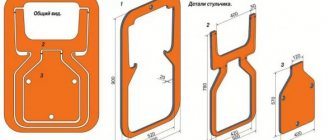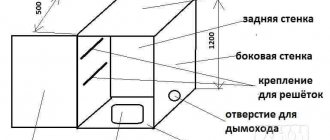Assembly method
- long boards are laid close to each other;
- using a tape measure, mark the edge boards at a distance of 2.5 cm from the edge and in the center of the tabletop;
- combine three 40 cm boards with markings;
- Drill holes with a drill and attach screws;
- align the table structure, balance it and tighten it tightly;
- carefully tighten the screws, avoiding distortions;
- polishing parts for painting;
- stain treatment;
- after drying, the table structure is turned over and fasteners are installed to install the legs;
- screwing the legs with screws.
The assembly itself does not take much time. More effort goes into making blanks. But in the end, the cost of the product will be significantly lower than the store price.
Peculiarities
A folding workbench when folded takes up to 10 times less space than when working.
- Portable - a version whose operating principle is similar to a folding chair or a regular extendable table that is easy to carry. The disadvantage is the almost complete absence of drawers, which noticeably weigh down the structure: instead of them there are one or two shelves without back walls, the workbench itself resembles a rack.
- Universal - a structure that is attached to the wall, but unlike a regular wall-mounted table, this table has all four legs. The scheme is complicated by retractable wheels, allowing you to use the workbench as a cart. This version is reminiscent of a mobile table for preparing hot dogs, popular among fast food sellers in the 90s of the last century: there are shelves with back walls (or full-fledged drawers). It can be folded against the wall, lifted and secured, and rolled to another place. Carrying requires the help of two more people: the weight is significant - tens of kilograms.
- folding wall- mounted workbench is used in a home “office” or utility room – outside the home. It is stylized to match the general design of a home interior, and can be made as a mini-transformer, from the appearance of which guests will not immediately guess that this is a workbench. A profile pipe can be used for the underbench.
Folding table for car
Many car enthusiasts are interested in how to make a folding table for a car. It is worth immediately noting that car tables also come in different designs and are distinguished by their individuality.
It all depends on the make of the car - if it fits one, then another car will require a completely different model of the table.
Most tables are distinguished by their fastening, which is intended for a specific part inside the cabin. Some are mounted directly on the steering wheel, others on the front panel.
Ceiling curtain rods - review of new products, design photos, combination options- Modern do-it-yourself book shelf: drawings, diagrams, options and best bookcase designs (140 photos)
How to make a mini bar with your own hands - the best ideas for a modern bar counter at home and in the country (75 photos)
You can also make or buy a folding table that hangs on the front passenger seat or is built in next to the driver on the gearbox.
Types of workbenches depending on the type of work and available space
Taking into account exactly how the DIY workbench will be used in the garage, you need to select the desired configuration:
- landline or mobile;
- with a fixed, permanent tabletop, or folding;
- with additional shelves/drawers/holders and other storage places or simplified, in the form of a table;
- straight, angular or U-shaped;
- free-standing or mounted near a wall.
Since space is usually not enough, it is better to plan a stationary workbench with your own hands near the wall, and place it in a corner or in the least used place in the garage or workshop.
Important: if the room has windows or a ventilation outlet, a draft is possible - you should not place the workplace in its path, otherwise problems with the back, neck and muscles heated during work are guaranteed.
A mobile folding workbench, made with your own hands from scrap materials, can be kept anywhere, and can be pulled out to a suitable place during use.
Before selecting a specific model and choosing its dimensions, it is advisable to estimate the amount of equipment and tools you already have or are planning to purchase - it is better to make a workplace “for growth” than to suffer in trying to attach additional devices to already crowded shelves.
For what?
The answer to this question is quite simple - you can choose the product model yourself.
Furniture stores offer only standard tables with fixed dimensions and colors.
The most typical models may not be suitable in size for a particular home or may not fit into an existing furniture set based on the wood shade.
When contacting an organization where furniture is made to order, you can count on developing a project that meets the customer’s wishes, but you should be prepared to pay quite a large sum for it.
Important! The price of the product will include not only the price of the material, but also a significant premium for manufacturing.
So, if there are a number of restrictions on choosing a table configuration, it is recommended to refer to the following instructions on how to make a folding table with your own hands.
How and from what to make
The most affordable and practical material is wood and its derivatives. Plywood, chipboard, fibreboard, OSB, countertops from already unnecessary tables, etc. will be a completely reasonable choice.
It is important to consider:
- if work is carried out in a damp room, it is necessary to choose a material that is protected from moisture - laminated, impregnated, followed by varnish/paint treatment;
- the working surface should be as flat and smooth as possible. Using boards of different thickness/texture/treatment will not allow you to obtain such a surface, so for the tabletop it is better to use a solid slab of plywood or wood board;
- guides and racks should be made of the same type and size of material, except in cases where the load is distributed unevenly and some of the racks require reinforcement;
- connections of wood materials are made using fasteners (screws, bolts, screws, confirmations) and glue, as well as a tongue-and-groove or tongue-and-groove system. The adhesive type of connection requires waiting for the glue to dry completely; in critical places, it is better to duplicate the gluing with metal fasteners.
It is necessary to assemble a workbench in a wooden garage with your own hands in a fairly dry and well-ventilated room - dust from sawing and sanding materials, fumes from varnish/paint must be removed quickly.
Important: since the load on the tabletop is often very large and uneven - for example, only on one corner - it must be reinforced by a frame or supports located under the main plane.
Recommendations
For clearer contact, the contact points between the parts are coated with wood glue. Strengthen glued joints using ready-made furniture corners or cut-off corner profiles. Strengthen corner joints where there is no contact with the drawers using triangular spacers.
It is advisable to immediately mount an extension cord with several sockets on the finished workbench - they will be needed to operate some power tools.
A folding workbench is hardly intended for heavy work such as assembling windows and doors. It makes turning operations difficult to produce massive parts weighing dozens of kilograms. For “heavy” work, it is better to assemble a stationary wooden workbench that can withstand a weight of more than one hundred kilograms.
- Regardless of how long the workbench is, it can be foldable (including a transformer). A one-room apartment or a small country house of 20-30 square meters is unlikely to allow you to place a stationary workbench that cannot be folded. Be guided primarily by the square footage of the living space. The same advice applies to an outside utility room or garage.
- Do not use plywood less than 15 mm thick or made from soft wood types for the tabletop. Such a workbench is only suitable for sewing work or activities that do not require the use of brute physical force.
- Do not work on a workbench with strong reagents, especially if there is frequent splashing. For chemically active work, special tables and stands, for example, made of glass, are used.
Folding tables
Traditional folding book tables are rare among models from Italian factories. They have almost been replaced by more convenient sliding models. The folding mechanism is sometimes used in designer models of dining tables and work tables.
An important advantage of book tables is their compactness when folded.
In the photo: the ultra-compact Calligaris Spazio book-table when folded can be placed against the wall as a console.
In the photo: Lago factory designers rethought the “book” principle. The Loto table can double its area thanks to its folding “corners”.
In the photo: the top of the Calligaris Flexy table folds “in two layers” thanks to hinges. As a result, the table area doubles. The height of the legs is also adjustable.
In the photo: folding table with Calligaris Spacebox cabinet. An excellent option for a studio apartment.
In the photo: the Bonaldo Flap round table turns into a rectangular table when unfolded.
Assembling a workbench for the garage with your own hands
You can make a garage table with your own hands if you follow the basic recommendations. The whole process can be divided into just a few steps:
- The existing material is being cut. A pipe and a steel angle can be used to form a supporting structure. A garage workbench with a metal frame can withstand significant impact.
- In order for the mechanic’s workbench to have the required dimensions, it is necessary to change the dimensions according to the drawings.
- You can start work by making a power frame. To begin with, a load-bearing element is created, on which another load-bearing element is installed on top, onto which a steel sheet is fixed. You can weld a workbench yourself using a welding preparation.
- The load-bearing element is additionally reinforced with steel pipes. They act as stiffeners.
- The table for metalwork is installed on legs. This structural element is also welded to the base. The recommended length of the elements used is about 900 mm. Power jumpers are welded between the legs. They can significantly increase the rigidity and stability of the mechanism.
- After creating the supporting element, you can begin to create boxes in which tools and parts will be stored. A DIY garage table is made for specific tasks. The number of boxes and their sizes may vary significantly. To create this element, a steel pipe is used. The frame of the boxes is reinforced with a metal channel, which becomes stiffening ribs.
- The next step is to make a supporting frame that is suitable for creating a tabletop. The frame must be very strong, since it will bear a high load. Due to the use of a thick metal pipe, the workbench is durable and reliable.
- After creating the supporting structure, it is further strengthened. To do this, the brackets are welded to the sides. Holes are drilled in the middle of each bracket, which are used to attach the back and other walls.
- Boxes may have plywood walls. Due to this, the workbench becomes lighter. The sides are secured using self-tapping screws. It is recommended to create boxes of various sizes, thereby significantly expanding the functionality of the device. There are various options for the location of drawers on the Internet; the most suitable option is selected depending on your preferences.
- Holes are created on the inside of the structure to fix the guides along which the boxes will move.
- In this case, a board is used to make the table. It is placed on a previously prepared frame, where it is then fixed. Often a metal plate is placed on top of the wood planks to protect the wood from the elements.
- All seams should be thoroughly cleaned. A grinding machine and a file can be used for this. If there are untreated seams, there is a high risk of injury. When processing seams, problems may arise associated with the appearance of cracks and other defects.
- The surface of the wood used must be well sanded. This creates a flat surface that is ideal for placing the steel sheet. Wooden sheets must be fastened securely, otherwise, when a load is applied, the sheet will move or sag.
- Fastening the metal sheet should be done using hidden screws. This is due to the fact that welding work can cause the previously used wood to ignite. The sheet used must be painted on both sides, due to which the service life of the workbench is significantly increased.
- Recently, schemes that allow you to change the height of a certain part of the structure have become very popular. The height of the workbench in the garage is selected taking into account what kind of work will be carried out.
Design options for transformable benches
It is not difficult to choose the appropriate option, since most of the folding benches are very similar to each other in design and operating principle. There are more than enough drawings of a transformer bench available for self-production, so there is plenty to choose from.
Another thing is that not all homemade products are equally good at using in a summer cottage, so it would be right to first understand the structure of the most popular models:
- The most common folding benches are transformers with a metal frame;
- Similar models of “folding beds”, but made of wood. A wooden transforming bench, in its basic dimensions and characteristics, approximately corresponds to metal models;
- Wooden benches are transformers of the original author's design, differing in the type of folding, size and shape;
- Small-sized frame benches of various designs.
The design of such little ones is often copied by developers from classic swing transformers, but there are also original products with unusual designs.
The diagram involves disassembling and assembling the transformer without fasteners
Many summer residents prefer to make such transformable benches with their own hands, photo, for only one reason. Thanks to their well-thought-out design and small size, they fold easily, take up little space and can be transported to the dacha even in a car.
The classic version of a folding transforming bench
The most common are universal models of folding benches with a metal frame. The transformer may look different, but it is based on the same circuit. Formally, such a bench consists of three parts:
- The stationary part is a small bench that always remains in one position, regardless of whether the transformer is unfolded or not;
- The movable part of the bench, when folded, complements the stationary part, increasing its size in width. In the unfolded position it is an independent seating area;
- The back of the bench. With any transformer design, it is always connected by hinges to the moving and stationary parts.
The size of the table with benches, into which the transformer turns when unfolded, is equal to the dimensions of the backrest. Therefore, such schemes in the folded position always have unusually high back support, which only increases the level of comfort for tall people and children.
The design of the bench does not involve the use of clamps or clamps; everything is held under its own weight
Important! All hinge joints are bolted and bushed and no door hinges or hinges are used. This solution increases the rigidity of the structure and makes it possible to build a transformer at the lowest cost.
The step-by-step instructions shown in the photo below will help you figure out how to fold or unfold a transformer bench with your own hands.
Folding diagram - grab the back and seat and pull it towards you
The transformer rotates around the hinge and moves into table position
Elements of a metal structure can be rounded in the form of arches or rectangular. If you wish, you can find your own drawings for a transformable iron bench made in an unusual square style.
The shape of the racks does not affect the performance of the circuit and is determined only by the individual preferences of the future owners. One of the transformer bench models, available for DIY assembly, is shown in the video
Wooden benches - folding beds
Models made from oak or larch wood look more attractive, although the operation scheme is practically no different from their metal counterparts.
Important! The only significant drawback is the impossibility of completely disassembling the wooden transformer.
If a bench on a metal frame can be disassembled into separate parts and assembled in the spring, then wooden furniture will have to be hidden in assembled form in a country house for the winter.
Transformer benches with unusual designs
Folding benches do not have to turn into a structure of two benches and a table. For example, to make your own, you can choose a design for a bench with a reclining backrest. In this case, the transformer is assembled in the form of a set of sections that can easily be converted into a folding table.
Another extremely interesting diagram of a transformer bench is presented below. The dimensions of the furniture do not differ from conventional models, but thanks to the special design of the seat and backrest, the latter can be quite easily hidden in the lower part of the structure.
A very simple shop - the transformer is shown in the photo below.
In terms of its design and operating principle, it resembles a folder or suitcase. Of all the options given, this model is perhaps best suited for working in the country during the summer season.
How to make a stand for a drill?
Making a mini-drilling machine with your own hands does not require high qualifications, but it greatly expands the scope of application of an ordinary electric drill. In addition, the machine will be much cheaper than a purchased one, and components can be borrowed from previously used devices.
Making a wooden stand will take very little time and will not require any special materials or tools:
- wooden blocks or boards no thinner than 20 mm;
- furniture guides;
- metal rod with thread for caliper;
- fasteners for wooden parts (screws, glue);
- emery.
Tools:
- hacksaw;
- vice;
- Screwdriver Set;
- electric drill.
Making a stand from metal requires a little more time and materials, so it is necessary to cover it in a little more detail.
The proposed metal stand is more versatile than one made of wood and includes:
- supporting frame;
- guide posts of the drill, to which it is attached and moved vertically;
- vertical tool feed handle;
- additional components for ease of use.
Making furniture yourself: advantages
Not every person can decide to independently manufacture various pieces of furniture, but such actions have several main advantages:
- Saving. This is a good opportunity to save your budget, because you don’t have to pay furniture makers for services.
- The most accurate measurements. You can not only pre-measure the place where the table will be installed, but also adjust some details while working.
- Creation of a unique design. Only on your own can you create an exclusive table that cannot be found on sale.
- Possibility to buy only good quality materials. Furniture shop craftsmen do not always act in good faith, and in order to earn more, they purchase low-quality materials and accessories. That is why it is recommended to do your own purchasing - you won’t fool yourself.
Making furniture with your own hands has a large number of obvious advantages.
Of course, in the absence of any skills in making furniture, making it yourself is a certain risk, because a beginner can simply ruin the materials due to inexperience. But, if you do everything slowly and thoughtfully, then even the first time you can get a very worthy result that you can be proud of.
Tool cabinet in the garage
This bedside table will serve both for performing a variety of tasks and for storing tools. It will take up very little space in the garage, and if you try, its pleasing appearance will decorate the room.
- First you need to draw up a plan diagram of such a bedside table. You can choose the proposed option, or based on it you can design your own, taking into account all your personal wishes for the arrangement of the workplace.
- For a novice carpenter, it will be useful to build a bedside table for storing working tools. This will allow you to acquire the necessary experience in carpentry and build the mini-workshop necessary for full-fledged work, which will fit in a small wooden box.
- The proposed tool cabinet in this case is a small floor cabinet. Inside it is equipped with nests for storing various tools, and outside it has a workbench board. It is made from plywood boards or boards 20 mm thick. The bench board must be carefully trimmed and trimmed.
The tool cabinet is equipped with two drawers: one hinged on the door, the other pull-out - the number of drawers and their functionality can be any depending on your needs. The top of the bedside table is equipped with a hinged lid in the form of a drawer. The lid is attached to the frame with hinges. In the working position, it can be folded back and leaned against the wall, or it can be equipped with holders so that it independently remains in a given position. When not in use, the lid will simply lower and close the bedside table.
To make the frame of the bedside table, you need to use either bars or boards with a cross section of 1.5 X 2 cm. The product can be lined with plywood or wood board.
The device for keeping tools in the cabinet is made at your own discretion.
- As you can see in the photo, this garage furniture is either painted or covered with film. You can use a transparent finish, but this will require more painstaking carpentry preparation of the product.
- The interior decoration can be simple; it will be enough just to carefully and repeatedly sand the parts from the inside or paint them with varnish or light-colored paint.
- Materials for assembling a workbench. Total cost of the workbench.
- To assemble a workbench you will not need a lot of materials with a total cost of 3 to 3.5 thousand rubles, depending on the place of purchase. For reference, prices from the Leroy Merlin store in the Moscow region will be indicated.
Lumber
- Planed block 30x40x2000 needles - 1 pc. (68 rub.)
- Planed board 40x96x3000 needles - 5 pcs. (1610 rub.)
- Planed board 20x96x3000 needles - 4 pcs. (620 rub.)
- Layout 14x14x2100 needles - 1 pc. (70 rub.)
Fasteners
- Bolt with nut and two washers M8x100 - 16 pcs. (416 rub.)
- Drywall-wood screws 3.5x45 200 pcs. — 1 box (147 rub.)
- Drywall-wood screws 4.2x90 6 pcs. — 3 packs (42 RUR)
- Furniture dowel 10x50, wood, beige, 30 pcs. — 1 package (47 rub.)
- Reinforced mounting angle 40x40x40x1.5 - 4 pcs. (52 rub.)
- Waterproof PVA glue D3 Tytan 200 g - 1 bottle (151 RUR)
Design options
Despite the fact that almost all models of transformers use the same scheme, almost all home-made workers try to design a folding bench in their own way, to make its design more individual and attractive.
Materials and tools
As previously noted, if you wish, you can make a workbench with your own hands. The workbench can be made from a corner or from a profile pipe, it all depends on the specific drawing.
Necessary tools for assembly and processing of materials used:
- Level. In order for the work carried out to be accurate, the device must be positioned horizontally.
- Metal processing is performed with a standard grinder. This tool will also be needed for grinding the surface, for which it is enough to replace the disk.
- The connection of all elements is carried out using a welding machine. The welding seam is characterized by high rigidity and reliability. Today, welding is used extremely often, since many people can purchase a compact welding machine.
- A tape measure or rigid ruler can be used for measurement.
- It is important to observe all dimensions, since its stability and other performance qualities depend on the accuracy of the design.
- Some elements can be connected using a screwdriver. Metal screws are used for connections.
- In some cases, several sheets of plywood are required to create a workbench
- You can change the shape by using an electric jigsaw.
- A drill is also required to work with materials. It allows you to obtain the required holes in metal and wood.
The required materials are as follows:
The main material used is steel angle. The wall thickness should be 4 mm, due to which the structure is highly resistant to mechanical stress.
- Square pipe 60 mm by 40 mm. The thickness of the metal used is 2 mm.
- A corner that measures 40 mm by 40 mm.
- Steel strip with a thickness of 4 mm and the required size to create a tabletop.
- A steel sheet of small thickness, which is required to create the sides of the structure.
- Wooden boards to create a shelving unit.
- Plywood, which is used to create boxes.
- Screws for fixing detachable elements.
- High strength guides for drawers.
- Paint that is used to protect wood and metal.
After finding everything you need, you can begin the actual work. It is worth considering that the materials in question are suitable for creating a structure that is quite impressive in size.
Due to its large dimensions, a vice can be placed on one side of the bench and tools on the other.











